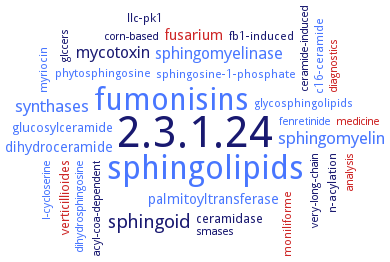2.3.1.24: sphingosine N-acyltransferase
This is an abbreviated version!
For detailed information about sphingosine N-acyltransferase, go to the full flat file.

Word Map on EC 2.3.1.24 
-
2.3.1.24
-
sphingolipids
-
fumonisins
-
sphingoid
-
synthases
-
sphingomyelin
-
sphingomyelinase
-
mycotoxin
-
fusarium
-
palmitoyltransferase
-
dihydroceramide
-
glucosylceramide
-
verticillioides
-
ceramidase
-
n-acylation
-
moniliforme
-
sphingosine-1-phosphate
-
myriocin
-
glycosphingolipids
-
llc-pk1
-
phytosphingosine
-
fb1-induced
-
c16-ceramide
-
corn-based
-
medicine
-
smases
-
very-long-chain
-
analysis
-
fenretinide
-
glccers
-
dihydrosphingosine
-
ceramide-induced
-
diagnostics
-
l-cycloserine
-
acyl-coa-dependent
- 2.3.1.24
- sphingolipids
- fumonisins
-
sphingoid
- synthases
- sphingomyelin
- sphingomyelinase
-
mycotoxin
- fusarium
- palmitoyltransferase
- dihydroceramide
- glucosylceramide
- verticillioides
- ceramidase
-
n-acylation
- moniliforme
- sphingosine-1-phosphate
- myriocin
- glycosphingolipids
-
llc-pk1
- phytosphingosine
-
fb1-induced
- c16-ceramide
-
corn-based
- medicine
- smases
-
very-long-chain
- analysis
- fenretinide
- glccers
- dihydrosphingosine
-
ceramide-induced
- diagnostics
- l-cycloserine
-
acyl-coa-dependent
Reaction
Synonyms
(dihydro)ceramide synthase, acyl-CoA : sphingosine N-acyltramferase, acyl-CoA : sphingosine N-acyltransferase, acyltransferase, sphingosine, C16:0-CerS, CER2, Cer3, ceramide synthase, ceramide synthase 4, ceramide synthase 5, ceramide synthase 6, ceramide synthetase, CerS, CerS4, CerS45, CerS5, CerS6, CNAG_02086, CNAG_02087, CNAG_06717, DLag1, Drosophila longevitiy assurance gene-1 homologue, fatty acyl-CoA:sphingosine acyltransferase, LAC1, LAG1, LAG1 longevity assurance homolog 2, LAG1 longevity assurance homolog 5, LAG12, LASS5, Lass6, LOH2, longevity assurance homolog 5, longevity assurance homolog 6, longevity assurance homologue 5, longevity assurance homologue 6, More, schlank, SpAT, sphinganine N-acyl transferase synthase, sphinganine N-acyltransferase, sphingosine acyltransferase, sphingosine N-acyltransferase, sphingosine/sphinganine acyltransferase, TcCerS, TcCERS1, TRAM homolog 4, translocating chain-associating membrane protein homolog 4, trh1-like, trh4


 results (
results ( results (
results ( top
top






